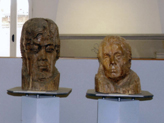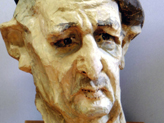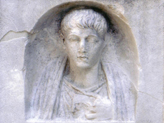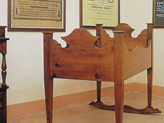Museo Civico "Luigi Varoli" - Cotignola
Corso Sforza, 21 48010 Cotignola
Tel. 0545 908879 - 908873
email mfabbri@comune.cotignola.ra.it
web http://www.museovaroli.it/
Aperto il venerdì dalle 16.30 alle 18.30
il sabato e la domenica dalle 10 alle 12 e alle 15.30 alle 18.30
Aperto anche su prenotazione
Ingresso gratuito
Accessibile ai diversamente abili
Il Museo Civico Luigi Varoli è un museo dislocato in più sedi comprese tra Palazzo Sforza, Casa Varoli e Casa Magnani. La tipologia delle collezioni, nata e costruitasi intorno alla donazione Varoli, che costituisce il cuore pulsante delle raccolte, abbraccia anche una sezione archeologica e la casa di Arialdo Magnani, un artista che fu allievo del maestro cotignolese.
L'eterogeneità delle collezioni risponde e corrisponde allo sguardo curioso ed inquieto che ha caratterizzato e attraversato la vita e le opere di Luigi Varoli, pittore, scultore (terracotta, cartapesta e ferro), musicista, maestro d'arte (e di vita) per adulti e bambini, in qualche modo archeologo e conservatore, raccoglitore di piccole mirabilia, uomo "giusto". Un fare urgente, febbrile e quotidiano il suo, imprescindibile dall'artigianalità e dal mestiere inteso come dialettica tra sapere antico e sperimentazione, filtrato da un approccio quasi animista nei confronti delle cose e dei materiali. Una ricchezza catturata, trattenuta e custodita gelosamente dai due luoghi che ne conservano memoria e lavoro: il Museo al primo piano di Palazzo Sforza e la Casa Varoli, che si trova esattamente di fronte.
Nella prima sede il percorso si costruisce e dipana intorno alle opere del maestro, i bellissimi mascheroni in cartapesta raffiguranti personaggi cotignolesi catturati in un periodo di grande povertà e umanità che è quello dell''immediato dopoguerra, la ritrattistica, sia pittorica che scultorea (terracotta, legno), gli autoritratti, i nudini e altri piccoli quadri intimi e privati, con pennellata infuocata, bruciante ed espressionista, dipinti estremamente vivaci e felici nel gesto impetuoso, materico e quasi stenografico, e poi alcuni quadri di maggiori dimensioni e molto noti come il "Ritratto della pittrice (Olga Settembrini) " e "'Uomo con vesciche".
La Casa Varoli è un vero e proprio scrigno che riporta alle atmosfere della casa d'artista, quasi una wunderkammer, tra teschi e crani di animali, burattini, marionette, gessi, strumenti musicali, maschere, fotografie del primo novecento, ex voto, crocifissi lignei, mobili antichi e una piccola ma preziosa biblioteca in cui spiccano due libri originali di Depero, tra cui il Dinamo Azari (quello "rilegato" con i bulloni). Un luogo affascinante, intrigante ed un po' misterioso, che si estende nel grazioso giardino ricco di reperti, con un interessante, bizzarro ed insolito muro di cinta, ricco di sorprese incastonate tra i mattoni.
La visita alla casa dell'artista permette quindi di completare il percorso avviato al Museo e di ben comprendere le differenti tensioni e contraddizioni che animavano l'impegno, la poetica e la vita del maestro, per certi versi scontroso, isolato e radicato ai suoi luoghi d'origine e appartenenza, eppur capace di mantenere contatti con autori internazionali come il già citato Depero, Moreni e con una schiera molto ampia di artisti che nella sua scuola si sono formati e incontrati animando un vero e proprio cenacolo. Una vocazione pedagogica, una generosità ed energia che ne hanno fatto un punto di riferimento per molti: ora artista, ora maestro, talvolta padre.
Per visitare la sezione archeologica si deve invece tornare al primo piano di Palazzo Sforza (qui una madonna lignea) e nel suo giardino con l'importante e ben conservata stele romana di Caio Vario.
L'ultima sede del museo è la casa di Magnani, pittore, poeta e ceramista, l'allievo più naif, e sognante di Luigi Varoli. Qui un piccolo mondo intatto, un teatro incantato, candido, felice, con lieve malinconia che veste e ammanta le piccole cose.
° ° ° ° ° ° ° ° ° ° ° ° ° ° ° ° ° ° ° ° ° ° ° ° ° ° ° ° ° ° ° ° ° ° ° ° ° ° ° ° ° ° ° ° ° ° ° ° ° °
Luigi Varoli was a true artist. His innate passion drove him to become a painter, and he practised all the arts -both as an artist and as a teacher- through his tireless curiosity and by trade.
There is no material, language or technique which remained unknown to him: he sculpted wood and stone, wrought iron, moulded clay and papier- maché, and played various instruments expertly.
Cotignola dedicated to him a Museum, which is a space for contemporary art and that is divided into three homes: Palazzo Sforza, Casa Varoli and Casa Magnani.
The first floor of Palazzo Sforza houses the exhibition of artworks by Luigi Varoli. Fifty years after his death, his works -including papier maché masks, caricatures, ceramics, sculptures in wood and iron, fiery paintings and cheerful and touching drawings- still convey all the energy of this extraordinary master and leading spirit of the twentieth century art scene in Romagna.
Portrait and figure painting were central to Varoli's artistic research. He modelled clay with an Impressionist touch and fired the finished pieces, modelling the faces of different people with an introspective eye: his parents, his wife, the Commendatore Scotti, a female friend and the prisoner serving a life sentence, to name just a few. Often he left these sculptures in the form of a rough draft, as if to suggest the impossibility of stopping the constant transformation of things in time.
Instead the five large heads in papier-maché, displayed at the Museum, were worn by the performers on the float "Ruscaia" and they were caricatures of various people from the town, known by their characteristic nicknames.
Finally, on the ground floor of the Palace, there are three rooms dedicated to the project of "Cantiere delle arti and Selvatico", which have been organising events and exhibitions for several years.
The second headquarter of the Museum is the house of Luigi Varoli.
Home to the School of Music, it became a veritable artist's home once more in 2008. The house offers you another vision of Varoli, an artist so deeply rooted in his environment that he pushed himself almost to isolation, yet he was in contact with some of the figures of the international art scene.
Now, fifty years after his death, the secret world of the artist has re-emerged from the archives and municipal storerooms. In fact the house exposes the most important books of his library, the catalogue of his photographs and postcards, his collected objects and intertwines his own drawings with those of his students, his private photographs with the casts in plaster.
The forge, the press, the lathe, the engraver's workbench and the easels of the painter and the sculptor dominate the space between the ever-present string instruments, lithographic stones, plaster models, animal bones and skulls, ancient local mementoes dating back to the years between the Roman and medieval ages and recent object of all kinds.
The last home of the Museum is the House of Arialdo Magnani.
Magnani is the poet of the "sentiment of colour", with the green landscapes captured early in the morning, the imaginary characters and houses with the ever-present cat, and of the clowns, first made in ceramics, with the irregular pressure of his hands and fingers, then painted an infinite number of times.
His house has remained intact, as he left in 1999 when he died. There is even the telephone, the pots he used for cooking, the bottles of wine and the wooden bucket he used to wash his clothes.
There are his ceramic doves which don't fly away, the wardrobe doors painted with his characters who watch you, suspended.




